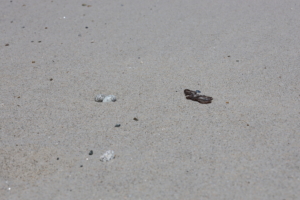Identifying Shorebird Eggs: Terns, Plovers, and Killdeer
Fishers Island is home to a variety of shorebird species, including terns, piping plovers, and killdeer. These birds are an integral part of the island’s ecosystem, each species playing a unique role. Understanding the differences between their eggs and breeding habits is crucial for their conservation. This article aims to educate on the distinctions between tern eggs, piping plover eggs, and killdeer eggs, and provide guidance on how to protect these species and their habitats.
Least Tern nesting, captured by Anna White
Tern Eggs
Characteristics
- Appearance: Tern eggs are typically speckled with dark spots and are usually olive or buff-colored, blending well with the sandy and pebbly substrates of their nesting sites.
- Size: They are generally smaller than plover and killdeer eggs.
- Clutch Size: Terns usually lay 1-3 eggs per clutch.
Breeding Habits
- Breeding Season: Terns breed from late May through July.

Two Least Tern eggs, captured by Anna White
- Habitat: Terns prefer nesting in colonies on sandy beaches, dunes, and salt marshes.
Conservation Status
- Common Terns (Sterna hirundo): Listed as “Special Concern” in some areas due to habitat loss and human disturbance.
- Least Terns (Sternula antillarum): Listed as “Endangered” or “Threatened” in many states due to similar threats, including habitat loss and predation.
Piping Plover Eggs
Spot the nesting Piping Plover! Captured by Anna White
Characteristics
- Appearance: Piping plover eggs are pale with fine speckling, often more camouflaged than tern eggs, blending seamlessly into the sandy environment.
- Size: Slightly larger than tern eggs.
- Clutch Size: Piping plovers lay 3-4 eggs per clutch.
Breeding Habits
- Breeding Season: Piping plovers breed from late April to July.
- Habitat: These birds nest on sandy beaches and gravelly shorelines, often near dune areas.
Four Piping Plover eggs, captured by Anna White
Conservation Status
- Piping Plover (Charadrius melodus): Listed as “Threatened” under the Endangered Species Act. Habitat loss and human interference are significant threats.
Killdeer Eggs
Characteristics
- Appearance: Killdeer eggs are buff-colored with black or brown blotches, providing excellent camouflage among rocks and gravel.
- Size: They are larger than both tern and piping plover eggs.
- Clutch Size: Killdeer lay 4-6 eggs per clutch.

Four Killdeer eggs, photographed by Tom and Pat Leeson.
Breeding Habits
- Breeding Season: Killdeer breed from March to August.
- Habitat: Unlike terns and plovers, killdeer often nest in open fields, gravelly areas, and even urban environments.
Conservation Status
- Killdeer (Charadrius vociferus): Not currently listed as endangered or threatened, but habitat disturbance can impact their populations.
Similarities Between Tern and Plover Eggs
Tern and piping plover eggs can appear quite similar at first glance. Both species lay eggs that are speckled and camouflaged to blend into sandy environments, making them difficult to spot. This similarity can sometimes lead to confusion in identifying the eggs, emphasizing the need for careful observation and proper identification techniques.
Overlapping Habitats and Conservation Tips
On Fishers Island, the habitats of these shorebirds can be quite close, particularly along sandy beaches and dunes. This proximity necessitates careful conservation efforts to prevent egg loss and ensure the birds’ survival.
Tips for Protecting Shorebird Eggs:
Spot the Piping Plover eggs! Captured by Anna White
- Respect Nesting Areas: Avoid disturbing marked nesting sites and keep a safe distance from birds during the breeding season.
- Keep Beaches Clean: Remove trash and avoid leaving food scraps that may attract predators.
- Control Pets: Keep dogs on leashes and away from nesting areas.
- Educate Others: Spread awareness about the importance of protecting these birds and their eggs.
- Support Conservation Efforts: Participate in local conservation programs and report any disturbances to authorities.
By understanding and respecting the breeding habits and habitats of terns, piping plovers, and killdeer, we can contribute to their conservation and ensure these beautiful shorebirds continue to thrive on Fishers Island.